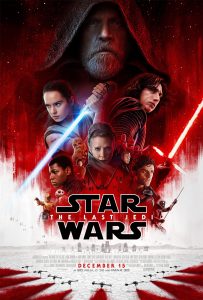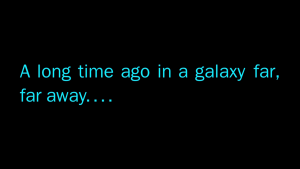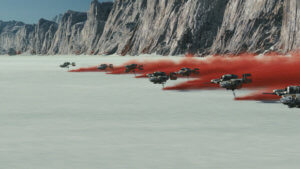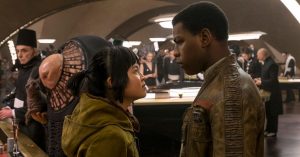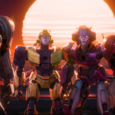WARNING: *Yoda voice* Spoilers in this article, there are!
Stars careening into focus on the screen. The rush of an x-wing fighter zipping past. The prickle of goosebumps on the skin as the familiar swell of the main theme accompanies the opening crawl. Truly, there is nothing like a Star Wars film to excite audiences spanning generations.
The nostalgic love that has been nurtured for decades coupled with the excitement of new faces joining a franchise so well-established seemed to be a formula for greatness what with the success of Star Wars: The Force Awakens 2 years ago. And, after leaving my cinema absolutely breathless, my skin still thrumming with energy, I would definitely say that its successor is just as enlivening–if not more.
Star Wars: The Last Jedi is an action-packed hit that holds key elements from its predecessors but is bold enough to experiment and, eventually, diverge. While the film has been divisive for some because of how it challenges how some characters are perceived or how the narrative unfolds in a way many didn’t expect, I believe it still packs a hefty punch and sets our galactic story down an exciting path.
The Last Jedi, first and foremost, is a visually stunning film. The most arresting and possibly memorable visual being that of Laura Dern’s Vice-Admiral Holdo jumping into lightspeed and ripping apart Supreme Leader Snoke’s flagship. Everything goes quiet, a wash of gasps filling the cinema when this happens. The Supremacy fractured on screen in slow motion, its debris falling away, surrounded by stars.
While galactic, epically-proportioned battles can surely be beautiful, the planets don’t disappoint either. Rey’s training takes place in Ahch-To, serene, full of life, and seemingly untouched in a star system tucked away, far from the battles. The craggy mountains and the running water paint a picture of remote beauty, perfect for Jedi training.
The planet Crait is another great example, covered in a blanket of white salt that, when disturbed, the top layer of white reveals a spray of red earth. Ski speeders slid across the white and trails of red followed them, the contrast pleasing to the eye. All-in-all, this film is shot beautifully and pays attention to details and how they inform the story.
In terms of narrative, The Last Jedi is, over-all, able to successfully layer several strands and points of tension. Some strands are, unfortunately, not as tight as others and can even be considered shakily-premised.
The Canto Bight excursion, for example, is one that could have been executed better and tighter. Taking down this city of lights, full of deception and dark beauty, has a lot to say in terms of political power and gain–it’s a shame that it’s rushed through and isn’t established so well. I cheered as the casino and many buildings were torn apart, but I wasn’t as invested as I feel the film wanted me to be.
Vice-Admiral Holdo refusing to inform Poe of the plan is also a little shaky, mostly because informing him would have saved a lot of trouble for a good number of characters (not that Holdo would’ve known about the plan, but the way the film sets up the plan seems to premise it on the very fact that Holdo is withholding information).
While it was important to show Poe’s plan failing so he could re-orient his priorities and be more than just the hotshot flyboy he’s called out to be, the idea that Holdo would keep her plan from him and from a majority of the crew is a little difficult to believe.
Yoda’s force ghost appearing and his power to affect his surroundings also felt a little out of place in the same league as Leia suddenly harnessing the force to bring herself back to the ship. These two shows of power could have been very useful in many other instances, so why now and why these circumstances? It could be argued, however, that these shows of power are supposed to help us probe at an even bigger question: Is all we know about the force really all there is to know? Could there be more?
Ultimately, however, these inconsistencies and questionable details are pretty forgivable on a larger scale–especially because the ninth movie could promise answers to these questions. The Last Jedi was still a thrilling addition to this franchise, packed with action and emotion. And, while it may look like it takes some steps its predecessors take, it still turns a lot of tropes and formulas we’ve gotten used to on their heads.
When The Force Awakens came out, there was plenty of buzz about who Rey’s parents were. She was a nobody in Jakku when she was pulled into this huge conflict with the First Order and the rebels and discovered she was Force-sensitive, hinting at a possible Jedi heritage.
Rian Johnson was well aware of the hype to the “big reveal” in terms of her parents and pulled the rug from underneath all of us viewers–Rey’s parents were nobodies. She isn’t secretly a Kenobi or another Skywalker out to endanger the entire galaxy. I love this about the film, I think this is a fantastic choice. Because it becomes a narrative of inclusion. Power and great responsibility are not always rooted in important, big names. Our heroes can come from anywhere. And, just as Kylo Ren invited her to the dark side and she entertained the thought, it is possible that our villains can have ordinary origins, too.
This is also a great point to make with the very last scene in mind. One of the kids in Canto Bight casually makes use of the force to sweep. It’s so nonchalant that I almost missed it, I had to make sure I wasn’t just making things up in my mind. It suddenly makes a powerful statement: This ropes in this child and, possibly, many more people on different planets. It is no longer just generals and leaders and droids involved, it is the people living on these planets, the people who do not pick up guns or bark orders from the bridge. We finally see the people that are being referred to in the vaguest way possible when leaders say they must “fight for the people.”
The Last Jedi reminds us that this story is a story of ordinary people not only measuring themselves up to the greats but even defeating them or exposing their wrongs. These ordinary people–a nobody from Jakku, a relatively unknown pilot, an ex-Stormtrooper, and a maintenance worker–suddenly have to deal with the mistakes of giants named Skywalker and risk their lives to rectify the mistakes of legends.
A lot of fans were angry at the choice of Rey’s nobody parents as well as Luke’s new, dejected outlook. But dissecting the legends and showing that they, too, were vulnerable, scared, and fallible is important. Johnson is trying to caution us not to hold on too tightly and to take a step back to examine everything.
Star Wars deals with the new, it always has. Not just in terms of space technology we can’t yet dream of, but in terms of storytelling. Layering strands to tie them again, later on, telling stories of different characters, building them to be iconic, and drawing out character arcs that trace a character’s move from dark to light or vice versa.
The Last Jedi does this, too. It betrays expectations. The earlier films believe that hope can hold order together, but we see how flimsy things become and how those who seek power will not rest. Rather than seek a way to uphold the institution that has failed, Johnson takes it apart. The Last Jedi seems reflexive enough to know when to start anew.
One of the earliest glimpses we have with this breaking of expectations is with Luke, a character so well-loved throughout the ages for his moral compass and his heart constantly turned to hope. The first scene is of him chucking his lightsaber over a cliff nonchalantly. It is here that many are caught off-guard. But it is also something I loved. His center could not hold, and he was demoralized–something that could easily happen to any of us, legend or not. The gravity of it is just intensified with him, because we all expect him to save the rebels and, eventually, the rest of the universe. Some of our heroes don’t live up to our expectations. Maybe our heroes are tired of being our heroes, too.
Just as in language where you have to understand its rules and conventions before you play and deviate, I believe that Rian Johnson shows a deep understanding of the world of Star Wars, its characters, and its rules–and this is where he attempts to break away. He looks deep into the psyche of a Luke aged by hardship and mistakes and deviates from the Luke we know–but in a believable way. And he does the same with a lot of the world for this film.
Johnson understands Star Wars, its world, its nuances. And this is how he is able to take its elements and play. He creates this movie and forges a new path, one that some of us are uneasy to follow, but others are refreshed by. This change might be necessary, and is a reflection of one of the film’s core statements: Maybe we need something different, something new, and let the past remain in the past.
This film reminded me why I first fell in love with the Star Wars movies in the first place by validating the older films, the lore, but still playing and rewriting what many thought would happen. It brings together the beginnings of the franchise, highlights its strengths, and then breaks away to make a name for itself. It makes us question elements from the universe we may have taken for granted and takes risks, delivering an incredible film that had me starry-eyed from start to finish.
What did you think of the film?
Let us know!

